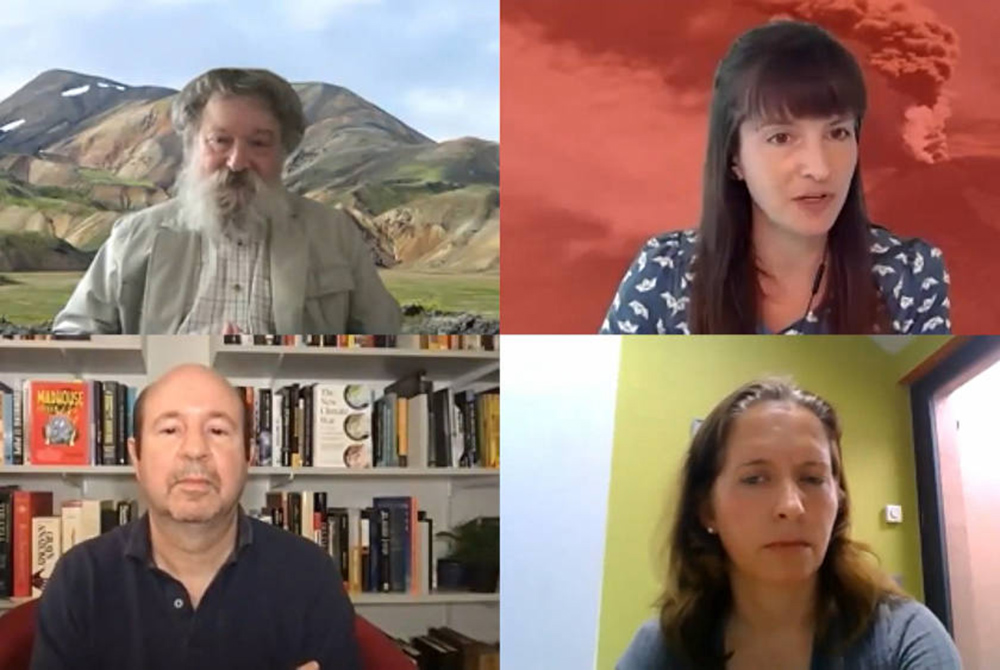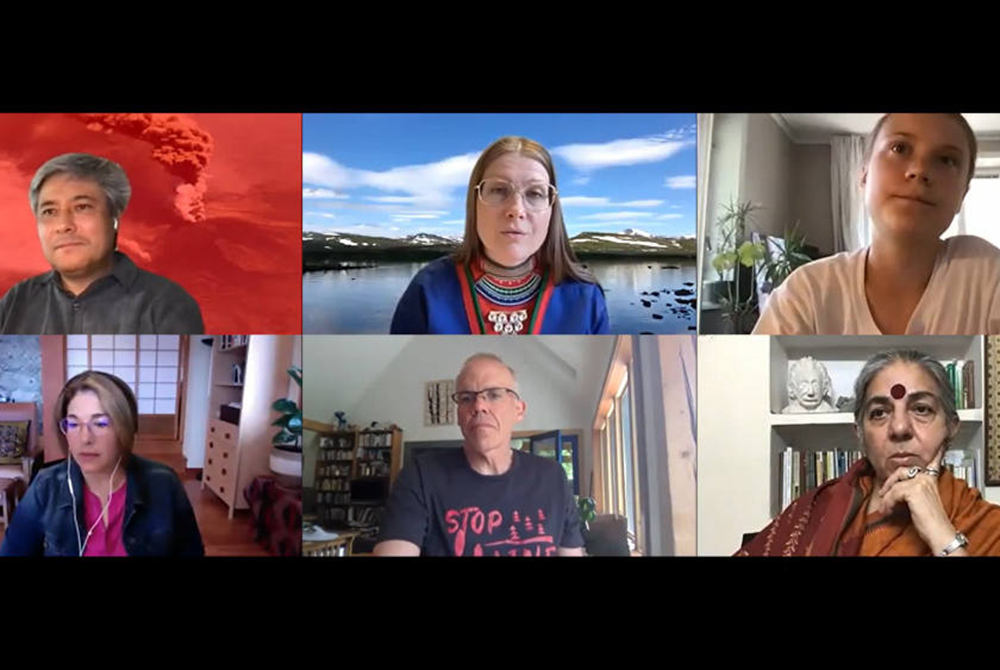
Panelists participate in "Solar Geoengineering: Warnings from Scientists, Indigenous Peoples, Youth, and Climate Activists," a June 9 webinar. From top left: Raymond Pierrehumbert of the University of Oxford; Lili Fuhr, panel moderator and head of the Heinrich Böll Foundation's International Environmental Policy Division; Michael Mann of Pennsylvania State University; and Jennie Stephens, director of the School of Public Policy and Urban Affairs at Northeastern University in Boston. (EarthBeat screenshot)
In the Book of Joshua in the Old Testament, the Israelite leader and successor to Moses prays to God to stop the sun to aid the Israelites in the midst of battle soon after they enter the Promised Land. Today, scientists are examining whether they can at least stop the sun's rays as a way to avoid the worst-case scenarios from a warming planet.
What sounds like science fiction is becoming a larger focus in deliberations and ethical discussions about solutions to climate change, as billionaires like Bill Gates back exploration into the technology of solar geoengineering while leading climate activists call it a delay tactic to avoid a swift global shift away from fossil fuels.
"There is definitely a use of technology [in addressing climate change], but the point of technology is that it has to serve humanity, instead of humanity serving technology," said Brian Green, director of technology ethics with the Markkula Center for Applied Ethics at Santa Clara University, who has followed the geoengineering debate for a decade.
Solar geoengineering is a subfield of geoengineering, which refers to efforts to alter the environment to limit the effects of climate change. One way of doing that is by pulling carbon dioxide from the atmosphere and putting it into storage, for example through reforestation or by pumping it underground. Solar geoengineering, also called solar radiation management, refers to efforts to cool the planet by reflecting more of the sun's rays back into space, so they do not make it to Earth.
There are two primary theories of how to do that: pumping aerosol particles, such as sulfur dioxide, into the upper atmosphere (known as stratospheric aerosol injection); and spraying sea salt into the sky to create low-level marine clouds over the ocean to reflect more light back into space (known as marine cloud brightening).
Neither is without controversy.
Most of the conversation on solar geoengineering has focused around stratospheric aerosol injection. The idea derives from the effect of volcanic eruptions, which have had a cooling effect on the planet. Following the 1991 eruption of Mount Pinatubo in the Philippines, the second-largest volcanic explosion of the past century, a massive ash cloud containing nearly 20 million tons of sulfur dioxide temporarily lowered average global temperatures by 0.5 degrees Celsius.
It's that impact potential that has caught the attention of solar geoengineering advocates like Gates. Under the Paris Agreement, the world's countries have committed to limiting global temperature rise to well below 2 C, and to strive to hold it to 1.5 C. Already, the planet has warmed roughly 1 C since the preindustrial 1880s.
So far, solar geoengineering technology is nowhere near the point of widespread deployment. Its advocates say research needs to happen now to better understand it, including the risks and unknown side effects, in order to determine if it can be used to slow climate change, even temporarily, to avoid the most catastrophic scenarios.
But opponents argue that even the study of the technology poses unnecessary risks and diverts attention from addressing the main cause of climate change: the emission of heat-trapping greenhouse gases, primarily from the burning of fossil fuels like coal, oil and natural gas.

Åsa Larsson Blind, president of the Saami Council, pictured June 9 during a webinar opposing solar geoengineering technology (EarthBeat screenshot)
Indigenous group blocks test
One of the recent fronts of the debate has been SCoPEx, a project of researchers at Harvard University, of which Gates is a funder, that would use a high-altitude balloon to release small quantities of mineral dust into the stratosphere.
The project's first test — to see if the balloon worked — was set for June in Sweden, but it was halted in March after the Saami Council, an Indigenous group representing members in Scandinavia, objected to it taking place on their land. In a letter to the SCoPEx advisory committee, the council urged that the test be canceled, called the project "a moral hazard" and said the experimental technology "entails risks of catastrophic consequences," including compromising global efforts to achieve net-zero emissions.
A second letter, signed by 36 Indigenous groups around the world, was sent to Harvard in June calling on the university to shut down the project entirely.
"Our position is clear that now is the time for all society to listen to what Mother Earth is telling us and what nature is telling us. We need to take a step back now, and our focus should be on finding a way to a sustainable, climate-friendly society," said Åsa Larsson Blind, president of the Saami Council, said during a webinar that month opposing solar geoengineering technology.
The virtual eSavent, organized by the Center for International Environmental Law, assembled a who's who of climate experts and activists, among them Greta Thunberg, Bill McKibben, Vandana Shiva, Naomi Klein and climate scientists Michael Mann of Pennsylvania State University and Raymond Pierrehumbert of the University of Oxford.
Pierrehumbert said injecting more chemicals into the Earth's atmosphere could cause severe regional climate disturbances, including disruption of the Indian monsoon and rainfall in Africa's Sahel region. He added that while climate models do well at forecasting large-scale changes in climate, they are less successful in projecting regional temperature and precipitation patterns, making it more difficult to determine the exact effects of solar geoengineering efforts.
The scientists on the panel also argued that approaches like solar geoengineering attempt to address symptoms of climate change and do nothing to address the root causes. As a result, they risk delaying actions to eliminate greenhouse gases if countries and companies see them as a cheaper strategy that allows continued use of fossil fuels. Such an approach places an unfair burden on future generations, Pierrehumbert said.
But it's the unintended consequences that cause the most concern. Reducing solar rays could make droughts more widespread, blunt plant and crop productivity and potentially change atmospheric circulation patterns in ways that actually warm some parts of the world faster. Even if the technology proved successful in reflecting sunlight back to space, the use of sulfur dioxide could produce acid rain, accelerating ocean acidification.

Niclas Hällström, executive Director of What Next?, top left, moderates the voices from movements panel, during a June 9 webinar, which included Åsa Larsson Blind, president of the Saami Council; Greta Thunberg; Naomi Klein; Bill McKibben; and Vandana Shiva. (EarthBeat screenshot)
"We are ultimately toying with a system that we don't understand perfectly, and the idea that we can cover up the effect of increased carbon pollution and the warming of the planet from that through some other unprecedented intervention with the system is, in my view, very foolish," Mann said.
Green told EarthBeat the concerns being raised about solar geoengineering are important ethical considerations. Shooting sulfur dioxide into the atmosphere, for instance, is "a pretty dangerous course of action," he said, as scientists do not know the right amount to use, how localized the effect would be or how long it would remain in the atmosphere.
There's also a moral danger, he added, that countries "get attracted toward the bad solution rather than the solution that actually solves your problem." It's these types of decisions that Pope Francis had in mind in his critique of the technocratic paradigm in his encyclical "Laudato Si', on Care for Our Common Home," Green said. In that document, the pope sought not to condemn all technology, but invited people to step back and consider how it can best serve humanity.
Green said solar geoengineering should be a last-resort approach, but he believes conducting research in small pilot studies now can reveal more insights into what it can accomplish and what specific impacts it could have.
"I don't think it can be counted out just because it's dangerous," Green said. "There might be situations that we get into that are so dire that we really need to think about technologies like this."
So far, those specific scenarios have not been identified, Pierrehumbert said, and that's part of the problem.
"If there is really no reasonable scenario where this can contribute significantly to addressing the problem of the climate crisis, why do the research?" he said during the webinar. "Because we know the research has risks in terms of moral hazard, in terms of developing technology that somebody else could easily deploy even if the scientists who developed it don't think it should be deployed."
Advertisement
Research calls for caution
As it stands, research into solar geoengineering continues.
Harvard hopes to restart its SCoPEx project by 2022, though its researchers have said they want to dialogue with the Saami Council about their concerns. Around the same time that SCoPEx paused, the National Academies of Sciences, Engineering and Medicine issued a report that recommended the U.S. government invest up to $200 million over five years in solar geoengineering research. It added that such a program should be only a minor part of the nation's overall research on responding to climate change.
Although the 300-plus page report recommended further research, that shouldn't be read as an endorsement of the technology, said Ed Maurer, chair of Santa Clara's department of civil, environmental and sustainability engineering and part of the Jesuit school's Environmental Justice and the Common Good Initiative. Scientists behind the report made that clear during a webinar on its release, he said, and they emphasized that climate policies must continue to center on reducing and eliminating carbon emissions.
"We're 150 years into a solar geoengineering experiment and we see what it does. We know how to undo it is to stop doing exactly what we've done to cause it," Maurer said.
He too sees a role for research — and an abundance of caution.
"There are a lot of reasons to be very cautious, and to be resistant at this stage to deploying anything," Maurer said.
Beyond the science, critics of solar geoengineering see sociopolitical issues at play as well. How, where and when countries might deploy the technology could lead to conflicts and put Indigenous and other historically marginalized communities at risk. Could a country use the technology as a weapon? Disputes could break out about what type of climate is optimal, or fights over food and other resources if crop yields drop.
And even if governments came to agreement on its use, it may require them to honor those commitments over long periods of time, or risk a quick release of pent-up warming.
"When we focus too much on technological change and not enough on social change, we really fail to prioritize social justice, economic justice, racial justice and all of these problematic power dynamics that [are behind] so many of our policies and priorities," Jennie Stephens, director of the School of Public Policy and Urban Affairs at Northeastern University in Boston, said during the webinar.
The Union of Concerned Scientists, which opposes solar geoengineering, has stressed that before tests begin outdoors, scientists and governments must put establish oversight mechanisms, transparency rules for research and ways to include the public, especially climate-vulnerable communities, in the decision-making.
The National Academies of Sciences report also recommends establishing a "robust governance" structure that includes transparency, limits on research and stakeholder engagement. That's a good sign, Maurer said. In conversations he's had with other scientists and engineers, he added, the prevailing sense is that solar geoengineering "doesn't even fall into the category of a climate solution," but is rather a way to buy time should global warming get really bad.
"The real intent is to avoid some other really severe potential impacts. But it's not going to do anything to solve the problem," he said.








